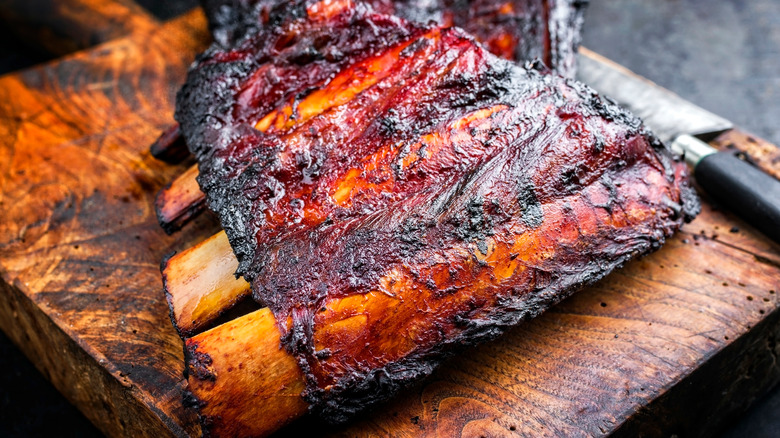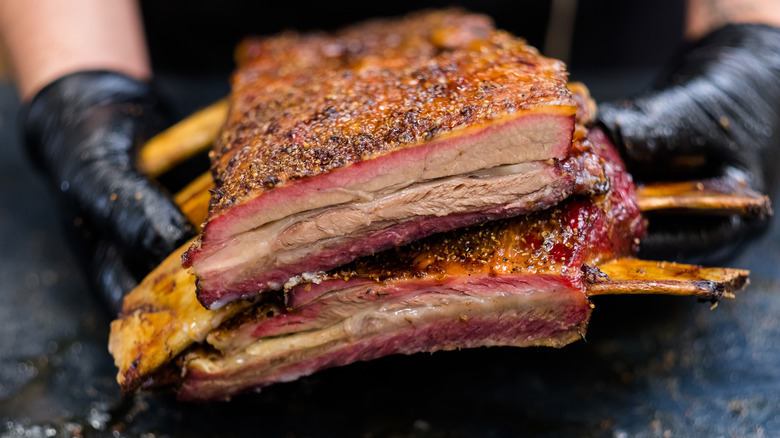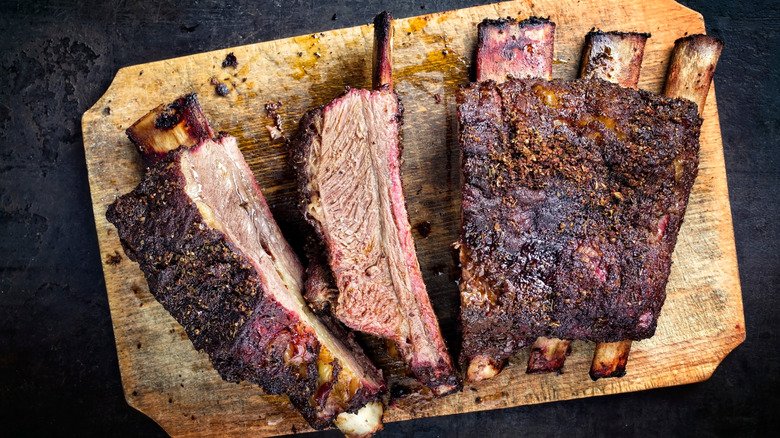The 3 Cuts Of Beef Ribs, Explained
While there's an ongoing debate as to which part of the United States offers up the best style of ribs, one thing we can all agree on is that they're delicious — regardless of the barbecue sauce or whether they're pork or beef. Nothing says summer quite like rolling up your sleeves and digging into a meaty, saucy set of ribs (bib optional, but recommended).
The average male steer is a massive animal, weighing up to a ton and a half, with a rib cage that is up to four feet long from the shoulder to the 13th rib. With that knowledge, it should come as no surprise that there isn't just a blanket "rib" cut when it comes to beef.
Ribs nine through 12 aren't used because they are mostly fat and lack any substantial meat for consumption. Typically, this meat is used for ground beef. However, ribs one through eight are what all of our inner cavemen know and love.
All three cuts of beef ribs come from a cow's 13 ribs, but how do they differ? Beef ribs can be divided into three categories depending on which area they come from: plate short ribs, chuck short ribs, and back ribs. Each cut of beef ribs is unique in its own right — from flavor to chewiness, to cooking method, all three deserve a moment in the spotlight. So, let's dig in and do Fred Flinstone proud.
Plate short ribs
Short ribs are not called "short" because of their stature; the moniker stems from the section they come from — the animal's short plate.
The short plate consists of ribs six through eight of the cow. They are cut from the front section near the chest and down toward the animal's stomach. In terms of meat cuts, they fall right in between where the brisket and flank steaks come from. Thanks to their neighbor, they take on a similar flavor — sometimes jokingly referred to as "brisket on a stick" or a "brisket popsicle." They are beefy, moist, fatty, and full of flavor.
They are known for their prolific meat and are often referred to as dino ribs. Plate short ribs can be somewhat harder to come by compared to the more popular chuck short ribs, but they are the perfect fit for smoking at a barbecue. Because of their high-fat content, they're best cooked at low temperatures for a longer period of time. A slow cooker or dutch oven will yield tender, fall-off-the-bone results.
Chuck short ribs
Everybody's favorite melt-in-your-mouth rib dishes are usually made with chuck short ribs. These are ribs two through five of the cow, found just above the brisket. Often enjoyed with a knife and fork — with no bib required — chuck short ribs are also commonly known as braising ribs, or just the blanket term, "short ribs."
Chuck short ribs have a strong, meaty flavor and plentiful intricate marbling. Low and slow (low heat for a long time) is the best way to cook them in order to break down the connective tissues and tenderize the cut of meat. They're often braised in red wine or another liquid to retain and add moisture.
Chuck short ribs are easier to find at supermarkets than other rib varieties, and when a recipe calls for beef short ribs, it probably means this cut. Korean-style BBQ short ribs are usually this cut, as are short rib sandwiches. The classic braised variations are often served upon a bed of mashed potatoes to soak up the flavorful beefy, umami-infused red wine sauce.
Back ribs
Unlike the other two cuts from the front side, back ribs are cut from the back, or loin, of the cow. They are found almost directly above the short rib cuts. Back ribs are attached to what we know as the prime rib, or rib roast. They typically have less meat attached to the bone than both of the short rib cuts, and this is because butchers allocate most of the meat found in this section to the pricey, money-making prime rib. Beef back ribs are the quintessential rack of beef ribs for the barbecue or grill, but they can also be smoked or braised.
When it comes to this cut, the simpler the cooking method, the better. As with the other two cuts, low and slow works best due to marbling and fat. Just add your favorite rub for smoking or choose a flavorful liquid for braising, and let time work its magic to break down the connective tissue and offer up a melt-in-your-mouth, meaty meal.
However, keep in mind that back ribs require a slightly shorter cooking time than the two short rib cuts. The meat and fat are between the bones in back ribs rather than in one big layer, making them leaner.



